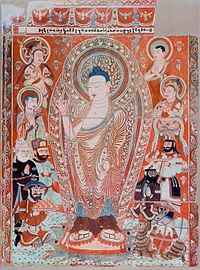User:Toothbrush/Sandbox2: Difference between revisions
Toothbrush (talk | contribs) No edit summary |
Toothbrush (talk | contribs) No edit summary |
||
| (22 intermediate revisions by the same user not shown) | |||
| Line 3: | Line 3: | ||
| bodyclass = continent | | bodyclass = continent | ||
| title = Mahaborei | | title = Mahaborei | ||
| image = [[File: | | image = [[File:Syr_Darya_Oblast._Kulanskii_Gorge_in_the_Kara_Tau_Range_WDL10970.png|275px]] | ||
| caption = Uzkan Mountains in Meuzon-Namia | | caption = Uzkan Mountains in Meuzon-Namia | ||
| label1 = Area | | label1 = Area | ||
| Line 24: | Line 24: | ||
| data9 = TBD | | data9 = TBD | ||
}} | }} | ||
Mahaborei is a term referring to the former lands of the [[ | Mahaborei, is a term referring to the former lands of the [[Magtal Khaganate]], which split apart during the [[Wars of Magtalese Succession]]. Mahaborei is one of the most populous regions in [[Sunalaya|the world]], with 4 nations: [[Kitami]], [[Golden Khathay]], cokke, and [[Meuzen-Namia]], totaling 400 million in population. These nations share many things in common, including, the [[Great Makhali Steepe]], the faith of [[Ilgecism]], and the [[Magtal-Altaic]] language family. However since the [[Wars of Magtalese Succession]], the 4 states have been mired in deep tension with each other. Various wars have been fought over the centuries, the most destructive of which was the [[Great Mahaborei War]] of the 70s. Since that war, the region has existed under a fragile peace. | ||
The geography of Mahaborei is characterized by vast steppes and plains, along with towering mountain ranges feeding vast river systems. Its primary climates are humid continental, oceanic, and subartic. These flat steppes has historically facilitated cultural interaction between East and West, with Mahaborei acting as a crossroads between both. As a result of this interaction, the region has developed a unique and varied culture, with distinct mythologies, traditions, and cuisines. One particularly unique feature is the region's treatment of monotheism, where all local deities are forms of the absolute [[Ilgecism#Trinitarism#The Beloved|beloved one]]. | |||
==Etymology== | ==Etymology== | ||
The name "Mahaborei" came from various Indic and Himalayian traders ... | |||
| Line 41: | Line 38: | ||
==Geography and Climate== | ==Geography and Climate== | ||
==Economy== | ==Economy== | ||
| Line 48: | Line 44: | ||
===Languages=== | ===Languages=== | ||
==Culture== | ==Culture== | ||
===Faith and Mythology=== | |||
{{Mahaborei topics}} | |||
Latest revision as of 01:00, 22 June 2020
This article is incomplete because it is pending further input from participants, or it is a work-in-progress by one author. Please comment on this article's talk page to share your input, comments and questions. Note: To contribute to this article, you may need to seek help from the author(s) of this page. |
 Uzkan Mountains in Meuzon-Namia | |
| Area | TBD |
|---|---|
| Population | TBD |
| Density | TBD |
| Denonym | Boryi |
| Languages and language families | TBD |
| Nominal GDP | TBD |
| GDP per capita | TBD |
| Time zones | TBD |
Mahaborei, is a term referring to the former lands of the Magtal Khaganate, which split apart during the Wars of Magtalese Succession. Mahaborei is one of the most populous regions in the world, with 4 nations: Kitami, Golden Khathay, cokke, and Meuzen-Namia, totaling 400 million in population. These nations share many things in common, including, the Great Makhali Steepe, the faith of Ilgecism, and the Magtal-Altaic language family. However since the Wars of Magtalese Succession, the 4 states have been mired in deep tension with each other. Various wars have been fought over the centuries, the most destructive of which was the Great Mahaborei War of the 70s. Since that war, the region has existed under a fragile peace.
The geography of Mahaborei is characterized by vast steppes and plains, along with towering mountain ranges feeding vast river systems. Its primary climates are humid continental, oceanic, and subartic. These flat steppes has historically facilitated cultural interaction between East and West, with Mahaborei acting as a crossroads between both. As a result of this interaction, the region has developed a unique and varied culture, with distinct mythologies, traditions, and cuisines. One particularly unique feature is the region's treatment of monotheism, where all local deities are forms of the absolute beloved one.
Etymology
The name "Mahaborei" came from various Indic and Himalayian traders ...
